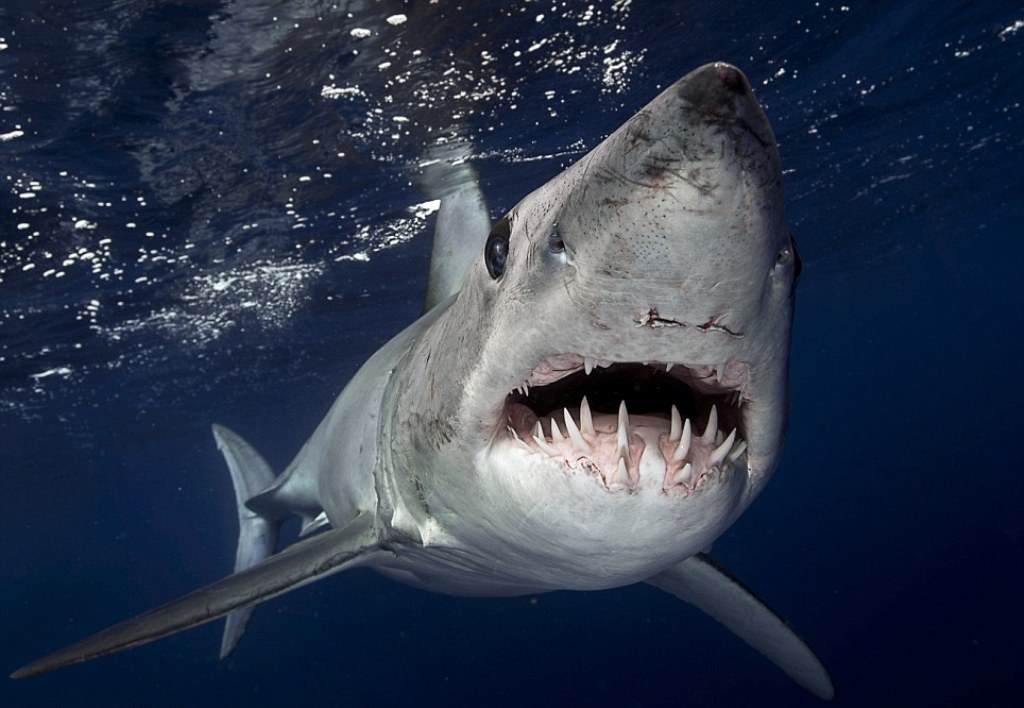The shortfin mako (Isurus oxyrinchus) is believed to be the fastest-swimming of all sharks, thought to be capable of attaining bursts of speed of up to 35 kilometres per hour, and famed for making spectacular leaps of up to six metres out of the water. The shortfin makos’ high tail produces maximum thrust to propel the shark rapidly forward, both in extreme bursts of speed, and for sustained, long-distance travel. The shortfin mako also has a heat exchange circulatory system that enables the body to be warmer than surrounding water, and thus maintain a high level of activity. This large, stream-lined shark has a distinctively crescent-shaped caudal fin, a long, conical snout, large black eyes and razor-sharp, blade-like teeth. The upper body is a brilliant metallic blue, while the underside is snow-white, with older, larger specimens tending to be darker with reduced white areas. Juveniles are therefore generally paler than adults, and also differ by possessing a clear black mark on the tip of their snout. The shortfin mako can be distinguished from the only other mako shark, the longfin mako (Isurus paucus), not only by having shorter pectoral fins, but also by the white colouration on the underside of the snout and around the mouth, which is darkly pigmented in the longfin mako.
Given this shark’s relative notoriety, particularly among anglers, surprisingly little is known of its biology. Reproductive knowledge of the solitary shortfin mako is sparse, largely because pregnant females usually abort embryos upon capture, making study difficult. Reproduction is ovoviviparous, with embryos being nourished in the uterus by a yolk sac rather than placenta. Once the young have hatched, uterine cannibalism known as oophagy occurs, in which the growing young feed on unfertilised or less-developed eggs. Litters of between 4 and 25 live young are born in the late winter and early spring, after a 15 to 18 month gestation period. This is followed by an initial relatively fast growth rate. Females are believed to rest for 18 months after birth before conceiving again. Females appear to become sexually mature at around 17 to 19 years of age and males mature around 7 to 9 years. The maximum known age of a shortfin mako is 32 years.
The shortfin mako primarily feeds on a wide variety of fishes, such as swordfish, tuna, mackerel, cod, sea bass, and even other sharks, including blue sharks (Prionace glauca), grey sharks (Carcharhinus species) and hammerheads (Sphyrna species). However, squid, sea turtle heads, and a ‘porpoise’ (probably a pelagic dolphin) have also been found in the stomachs of these sharks. This is a wide-ranging shark found in tropical and temperate waters throughout the world’s oceans. In the Western Atlantic, the shortfin mako occurs from the Gulf of Maine to southern Brazil, including the Gulf of Mexico and the Caribbean. In the Eastern Atlantic, the distribution ranges from Norway, down past the British Isles, the Mediterranean, the Ivory Coast and Ghana to South Africa. In the Indo-Pacific, the shortfin mako shark is found from East Africa and the Red Sea to Hawaii, including waters around Pakistan, India, Korea, Japan, Indonesia, Australia, Tasmania, and New Zealand. In the Eastern Pacific, the range includes waters south of the Aleutian Islands and from Southern California, USA, to Chile. The shortfin mako is usually pelagic, but can sometimes be found close inshore. Although normally occupying surface waters down to around 150 metres, this shark has been recorded at depths of up to 740 metres. There is evidence to suggest that this species migrates seasonally to warmer waters.





0 komentar:
Post a Comment